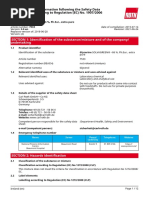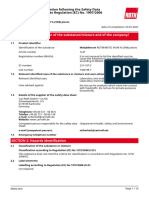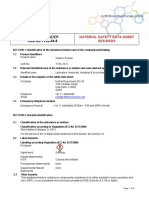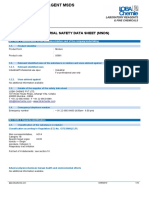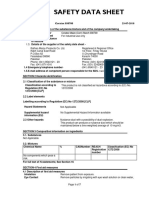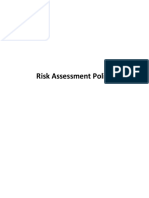SDB 5778 MT en
SDB 5778 MT en
Uploaded by
abdoulrhman.amirCopyright:
Available Formats
SDB 5778 MT en
SDB 5778 MT en
Uploaded by
abdoulrhman.amirOriginal Title
Copyright
Available Formats
Share this document
Did you find this document useful?
Is this content inappropriate?
Copyright:
Available Formats
SDB 5778 MT en
SDB 5778 MT en
Uploaded by
abdoulrhman.amirCopyright:
Available Formats
Voluntary safety information following the Safety Data
Sheet format according to Regulation (EC) No. 1907/2006
(REACH)
Sorbitol MacConkey Agar ISO 11133, ISO 16654 for microbiology
article number: 5778 date of compilation: 09.09.2021
Version: 1.0 en
SECTION 1: Identification of the substance/mixture and of the company/
undertaking
1.1 Product identifier
Identification of the substance Sorbitol MacConkey Agar ISO 11133, ISO 16654
for microbiology
Article number 5778
Registration number (REACH) not relevant (mixture)
1.2 Relevant identified uses of the substance or mixture and uses advised against
Relevant identified uses: Laboratory chemical
Laboratory and analytical use
Uses advised against: Do not use for products which come into contact
with foodstuffs. Do not use for private purposes
(household).
1.3 Details of the supplier of the safety data sheet
Carl Roth GmbH + Co KG
Schoemperlenstr. 3-5
D-76185 Karlsruhe
Germany
Telephone:+49 (0) 721 - 56 06 0
Telefax: +49 (0) 721 - 56 06 149
e-mail: sicherheit@carlroth.de
Website: www.carlroth.de
Competent person responsible for the safety data :Department Health, Safety and Environment
sheet:
e-mail (competent person): sicherheit@carlroth.de
1.4 Emergency telephone number
SECTION 2: Hazards identification
2.1 Classification of the substance or mixture
Classification according to Regulation (EC) No 1272/2008 (CLP)
This mixture does not meet the criteria for classification in accordance with Regulation No 1272/2008/
EC.
2.2 Label elements
Labelling according to Regulation (EC) No 1272/2008 (CLP)
not required
2.3 Other hazards
Results of PBT and vPvB assessment
This mixture does not contain any substances that are assessed to be a PBT or a vPvB.
Malta (en) Page 1 / 12
Voluntary safety information following the Safety Data
Sheet format according to Regulation (EC) No. 1907/2006
(REACH)
Sorbitol MacConkey Agar ISO 11133, ISO 16654 for microbiology
article number: 5778
SECTION 3: Composition/information on ingredients
3.1 Substances
not relevant (mixture)
3.2 Mixtures
Description of the mixture
Name of sub- Identifier Wt% Classification acc. to Pictograms Notes
stance GHS
Deoxycholic acid sodi- CAS No 1,455 Acute Tox. 4 / H302
um salt 302-95-4 Skin Irrit. 2 / H315
Eye Irrit. 2 / H319
EC No STOT SE 3 / H335
206-132-7
Name of sub- Identifier Specific Conc. Limits M-Factors ATE Exposure
stance route
Deoxycholic acid CAS No - - 1.370 mg/kg oral
sodium salt 302-95-4
EC No
206-132-7
For full text of abbreviations: see SECTION 16
SECTION 4: First aid measures
4.1 Description of first aid measures
General notes
Take off contaminated clothing.
Following inhalation
Provide fresh air.
Following skin contact
Rinse skin with water/shower.
Following eye contact
Rinse cautiously with water for several minutes.
Following ingestion
Rinse mouth. Call a doctor if you feel unwell.
4.2 Most important symptoms and effects, both acute and delayed
Symptoms and effects are not known to date.
4.3 Indication of any immediate medical attention and special treatment needed
none
Malta (en) Page 2 / 12
Voluntary safety information following the Safety Data
Sheet format according to Regulation (EC) No. 1907/2006
(REACH)
Sorbitol MacConkey Agar ISO 11133, ISO 16654 for microbiology
article number: 5778
SECTION 5: Firefighting measures
5.1 Extinguishing media
Suitable extinguishing media
co-ordinate firefighting measures to the fire surroundings
water, foam, alcohol resistant foam, dry extinguishing powder, ABC-powder
Unsuitable extinguishing media
water jet
5.2 Special hazards arising from the substance or mixture
Combustible.
Hazardous combustion products
In case of fire may be liberated: Nitrogen oxides (NOx), Carbon monoxide (CO), Carbon dioxide (CO₂),
May produce toxic fumes of carbon monoxide if burning.
5.3 Advice for firefighters
In case of fire and/or explosion do not breathe fumes. Fight fire with normal precautions from a reas-
onable distance. Wear self-contained breathing apparatus.
SECTION 6: Accidental release measures
6.1 Personal precautions, protective equipment and emergency procedures
For non-emergency personnel
Control of dust.
6.2 Environmental precautions
Keep away from drains, surface and ground water.
6.3 Methods and material for containment and cleaning up
Advice on how to contain a spill
Covering of drains. Take up mechanically.
Advice on how to clean up a spill
Take up mechanically.
Other information relating to spills and releases
Place in appropriate containers for disposal. Ventilate affected area.
6.4 Reference to other sections
Hazardous combustion products: see section 5. Personal protective equipment: see section 8. Incom-
patible materials: see section 10. Disposal considerations: see section 13.
Malta (en) Page 3 / 12
Voluntary safety information following the Safety Data
Sheet format according to Regulation (EC) No. 1907/2006
(REACH)
Sorbitol MacConkey Agar ISO 11133, ISO 16654 for microbiology
article number: 5778
SECTION 7: Handling and storage
7.1 Precautions for safe handling
No special measures are necessary.
Advice on general occupational hygiene
Keep away from food, drink and animal feedingstuffs.
7.2 Conditions for safe storage, including any incompatibilities
Store in a dry place.
Incompatible substances or mixtures
Observe hints for combined storage.
Consideration of other advice:
Ventilation requirements
Use local and general ventilation.
Specific designs for storage rooms or vessels
Recommended storage temperature: 15 – 25 °C
7.3 Specific end use(s)
No information available.
SECTION 8: Exposure controls/personal protection
8.1 Control parameters
National limit values
Occupational exposure limit values (Workplace Exposure Limits)
Data are not available.
8.2 Exposure controls
Individual protection measures (personal protective equipment)
Eye/face protection
Use safety goggle with side protection.
Skin protection
• hand protection
Wear suitable gloves. Chemical protection gloves are suitable, which are tested according to EN 374.
• type of material
NBR (Nitrile rubber)
Malta (en) Page 4 / 12
Voluntary safety information following the Safety Data
Sheet format according to Regulation (EC) No. 1907/2006
(REACH)
Sorbitol MacConkey Agar ISO 11133, ISO 16654 for microbiology
article number: 5778
• material thickness
>0,11 mm
• breakthrough times of the glove material
>480 minutes (permeation: level 6)
• other protection measures
Take recovery periods for skin regeneration. Preventive skin protection (barrier creams/ointments) is
recommended.
Respiratory protection
Respiratory protection necessary at: Dust formation. Particulate filter device (EN 143). P1 (filters at
least 80 % of airborne particles, colour code: White).
Environmental exposure controls
Keep away from drains, surface and ground water.
SECTION 9: Physical and chemical properties
9.1 Information on basic physical and chemical properties
Physical state solid
Colour beige
Odour characteristic
Melting point/freezing point not determined
Boiling point or initial boiling point and boiling (unknown) not determined
range
Flammability this material is combustible, but will not ignite
readily
Lower and upper explosion limit not determined
Flash point not applicable
Auto-ignition temperature not determined
Decomposition temperature not relevant
pH (value) 6,9 – 7,3
Kinematic viscosity not relevant
Solubility(ies)
Water solubility miscible in any proportion
Partition coefficient
Partition coefficient n-octanol/water (log value): this information is not available
Vapour pressure not determined
Malta (en) Page 5 / 12
Voluntary safety information following the Safety Data
Sheet format according to Regulation (EC) No. 1907/2006
(REACH)
Sorbitol MacConkey Agar ISO 11133, ISO 16654 for microbiology
article number: 5778
Density not determined
Relative vapour density information on this property is not available
Particle characteristics No data available.
Other safety parameters
Oxidising properties none
9.2 Other information
Information with regard to physical hazard hazard classes acc. to GHS
classes: (physical hazards): not relevant
Other safety characteristics:
Miscibility completely miscible with water
SECTION 10: Stability and reactivity
10.1 Reactivity
The product in the delivered form is not dust explosion capable; the enrichment of fine dust however
leads to the danger of dust explosion.
10.2 Chemical stability
The material is stable under normal ambient and anticipated storage and handling conditions of tem-
perature and pressure.
10.3 Possibility of hazardous reactions
Violent reaction with: strong oxidiser
10.4 Conditions to avoid
There are no specific conditions known which have to be avoided.
10.5 Incompatible materials
There is no additional information.
10.6 Hazardous decomposition products
Hazardous combustion products: see section 5.
SECTION 11: Toxicological information
11.1 Information on hazard classes as defined in Regulation (EC) No 1272/2008
Test data are not available for the complete mixture.
Classification procedure
The method for classification of the mixture is based on ingredients of the mixture (additivity
formula).
Classification according to GHS (1272/2008/EC, CLP)
This mixture does not meet the criteria for classification in accordance with Regulation No 1272/2008/
EC.
Malta (en) Page 6 / 12
Voluntary safety information following the Safety Data
Sheet format according to Regulation (EC) No. 1907/2006
(REACH)
Sorbitol MacConkey Agar ISO 11133, ISO 16654 for microbiology
article number: 5778
Acute toxicity
Shall not be classified as acutely toxic.
Acute toxicity estimate (ATE) of components of the mixture
Name of substance CAS No Exposure route ATE
Deoxycholic acid sodium salt 302-95-4 oral 1.370 mg/kg
Acute toxicity of components of the mixture
Name of substance CAS No Exposure Endpoint Value Species
route
Deoxycholic acid sodium salt 302-95-4 oral LD50 1.370 mg/kg rat
Skin corrosion/irritation
Shall not be classified as corrosive/irritant to skin.
Serious eye damage/eye irritation
Shall not be classified as seriously damaging to the eye or eye irritant.
Respiratory or skin sensitisation
Shall not be classified as a respiratory or skin sensitiser.
Germ cell mutagenicity
Shall not be classified as germ cell mutagenic.
Carcinogenicity
Shall not be classified as carcinogenic.
Reproductive toxicity
Shall not be classified as a reproductive toxicant.
Specific target organ toxicity - single exposure
Shall not be classified as a specific target organ toxicant (single exposure).
Specific target organ toxicity - repeated exposure
Shall not be classified as a specific target organ toxicant (repeated exposure).
Aspiration hazard
Shall not be classified as presenting an aspiration hazard.
Symptoms related to the physical, chemical and toxicological characteristics
• If swallowed
Data are not available.
• If in eyes
Data are not available.
• If inhaled
Data are not available.
• If on skin
Data are not available.
Malta (en) Page 7 / 12
Voluntary safety information following the Safety Data
Sheet format according to Regulation (EC) No. 1907/2006
(REACH)
Sorbitol MacConkey Agar ISO 11133, ISO 16654 for microbiology
article number: 5778
• Other information
Health effects are not known.
11.2 Endocrine disrupting properties
None of the ingredients are listed.
11.3 Information on other hazards
There is no additional information.
SECTION 12: Ecological information
12.1 Toxicity
Shall not be classified as hazardous to the aquatic environment.
.
Biodegradation
Data are not available.
12.2 Process of degradability
Data are not available.
12.3 Bioaccumulative potential
Data are not available.
12.4 Mobility in soil
Data are not available.
12.5 Results of PBT and vPvB assessment
Data are not available.
12.6 Endocrine disrupting properties
None of the ingredients are listed.
12.7 Other adverse effects
Data are not available.
SECTION 13: Disposal considerations
13.1 Waste treatment methods
Consult the appropriate local waste disposal expert about waste disposal.
Sewage disposal-relevant information
Do not empty into drains.
13.2 Relevant provisions relating to waste
The allocation of waste identity numbers/waste descriptions must be carried out according to the
EEC, specific to the industry and process. Waste catalogue ordinance (Germany).
13.3 Remarks
Waste shall be separated into the categories that can be handled separately by the local or national
waste management facilities. Please consider the relevant national or regional provisions.
Malta (en) Page 8 / 12
Voluntary safety information following the Safety Data
Sheet format according to Regulation (EC) No. 1907/2006
(REACH)
Sorbitol MacConkey Agar ISO 11133, ISO 16654 for microbiology
article number: 5778
SECTION 14: Transport information
14.1 UN number or ID number not subject to transport regulations
14.2 UN proper shipping name not assigned
14.3 Transport hazard class(es) none
14.4 Packing group not assigned
14.5 Environmental hazards non-environmentally hazardous acc. to the dan-
gerous goods regulations
14.6 Special precautions for user
There is no additional information.
14.7 Maritime transport in bulk according to IMO instruments
The cargo is not intended to be carried in bulk.
14.8 Information for each of the UN Model Regulations
Transport of dangerous goods by road, rail and inland waterway (ADR/RID/ADN) - Additional
information
Not subject to ADR, RID and ADN.
International Maritime Dangerous Goods Code (IMDG) - Additional information
Not subject to IMDG.
International Civil Aviation Organization (ICAO-IATA/DGR) - Additional information
Not subject to ICAO-IATA.
SECTION 15: Regulatory information
15.1 Safety, health and environmental regulations/legislation specific for the substance or mixture
Relevant provisions of the European Union (EU)
Restrictions according to REACH, Annex XVII
none of the ingredients are listed
List of substances subject to authorisation (REACH, Annex XIV)/SVHC - candidate list
None of the ingredients are listed. (Or Concentration of the substance in a mixture: <0.1 % Mass con-
centration)
Seveso Directive
2012/18/EU (Seveso III)
No Dangerous substance/hazard categories Qualifying quantity (tonnes) for the ap- Notes
plication of lower and upper-tier re-
quirements
not assigned
Deco-Paint Directive
VOC content 0%
Malta (en) Page 9 / 12
Voluntary safety information following the Safety Data
Sheet format according to Regulation (EC) No. 1907/2006
(REACH)
Sorbitol MacConkey Agar ISO 11133, ISO 16654 for microbiology
article number: 5778
Industrial Emissions Directive (IED)
VOC content 0%
Directive on the restriction of the use of certain hazardous substances in electrical and
electronic equipment (RoHS)
none of the ingredients are listed
Regulation concerning the establishment of a European Pollutant Release and Transfer
Register (PRTR)
none of the ingredients are listed
Water Framework Directive (WFD)
List of pollutants (WFD)
Name of substance Name acc. to inventory CAS No Listed in Remarks
Deoxycholic acid sodium salt Metals and their compounds A)
Legend
A) Indicative list of the main pollutants
Regulation on the marketing and use of explosives precursors
none of the ingredients are listed
Regulation on drug precursors
none of the ingredients are listed
Regulation on substances that deplete the ozone layer (ODS)
none of the ingredients are listed
Regulation concerning the export and import of hazardous chemicals (PIC)
none of the ingredients are listed
Regulation on persistent organic pollutants (POP)
none of the ingredients are listed
Other information
Directive 94/33/EC on the protection of young people at work. Observe employment restrictions un-
der the Maternity Protection Directive (92/85/EEC) for expectant or nursing mothers.
National inventories
Country Inventory Status
AU AICS not all ingredients are listed
CA DSL not all ingredients are listed
CN IECSC all ingredients are listed
EU ECSI all ingredients are listed
EU REACH Reg. not all ingredients are listed
JP CSCL-ENCS not all ingredients are listed
JP ISHA-ENCS not all ingredients are listed
KR KECI not all ingredients are listed
Malta (en) Page 10 / 12
Voluntary safety information following the Safety Data
Sheet format according to Regulation (EC) No. 1907/2006
(REACH)
Sorbitol MacConkey Agar ISO 11133, ISO 16654 for microbiology
article number: 5778
Country Inventory Status
MX INSQ not all ingredients are listed
NZ NZIoC not all ingredients are listed
PH PICCS not all ingredients are listed
TR CICR not all ingredients are listed
TW TCSI all ingredients are listed
US TSCA not all ingredients are listed
Legend
AICS Australian Inventory of Chemical Substances
CICR Chemical Inventory and Control Regulation
CSCL-ENCS List of Existing and New Chemical Substances (CSCL-ENCS)
DSL Domestic Substances List (DSL)
ECSI EC Substance Inventory (EINECS, ELINCS, NLP)
IECSC Inventory of Existing Chemical Substances Produced or Imported in China
INSQ National Inventory of Chemical Substances
ISHA-ENCS Inventory of Existing and New Chemical Substances (ISHA-ENCS)
KECI Korea Existing Chemicals Inventory
NZIoC New Zealand Inventory of Chemicals
PICCS Philippine Inventory of Chemicals and Chemical Substances (PICCS)
REACH Reg. REACH registered substances
TCSI Taiwan Chemical Substance Inventory
TSCA Toxic Substance Control Act
15.2 Chemical Safety Assessment
Chemical safety assessments for substances in this mixture were not carried out.
SECTION 16: Other information
Abbreviations and acronyms
Abbr. Descriptions of used abbreviations
Acute Tox. Acute toxicity
ADN Accord européen relatif au transport international des marchandises dangereuses par voies de naviga-
tion intérieures (European Agreement concerning the International Carriage of Dangerous Goods by In-
land Waterways)
ADR Accord relatif au transport international des marchandises dangereuses par route (Agreement concern-
ing the International Carriage of Dangerous Goods by Road)
ATE Acute Toxicity Estimate
CAS Chemical Abstracts Service (service that maintains the most comprehensive list of chemical substances)
CLP Regulation (EC) No 1272/2008 on classification, labelling and packaging of substances and mixtures
DGR Dangerous Goods Regulations (see IATA/DGR)
EC No The EC Inventory (EINECS, ELINCS and the NLP-list) is the source for the seven-digit EC number, an identi-
fier of substances commercially available within the EU (European Union)
EINECS European Inventory of Existing Commercial Chemical Substances
ELINCS European List of Notified Chemical Substances
Eye Dam. Seriously damaging to the eye
Eye Irrit. Irritant to the eye
GHS "Globally Harmonized System of Classification and Labelling of Chemicals" developed by the United Na-
tions
Malta (en) Page 11 / 12
Voluntary safety information following the Safety Data
Sheet format according to Regulation (EC) No. 1907/2006
(REACH)
Sorbitol MacConkey Agar ISO 11133, ISO 16654 for microbiology
article number: 5778
Abbr. Descriptions of used abbreviations
IATA International Air Transport Association
IATA/DGR Dangerous Goods Regulations (DGR) for the air transport (IATA)
ICAO International Civil Aviation Organization
IMDG International Maritime Dangerous Goods Code
index No The Index number is the identification code given to the substance in Part 3 of Annex VI to Regulation
(EC) No 1272/2008
LD50 Lethal Dose 50 %: the LD50 corresponds to the dose of a tested substance causing 50 % lethality during a
specified time interval
NLP No-Longer Polymer
PBT Persistent, Bioaccumulative and Toxic
REACH Registration, Evaluation, Authorisation and Restriction of Chemicals
RID Règlement concernant le transport International ferroviaire des marchandises Dangereuses (Regula-
tions concerning the International carriage of Dangerous goods by Rail)
Skin Corr. Corrosive to skin
Skin Irrit. Irritant to skin
STOT SE Specific target organ toxicity - single exposure
SVHC Substance of Very High Concern
VOC Volatile Organic Compounds
vPvB Very Persistent and very Bioaccumulative
Key literature references and sources for data
Regulation (EC) No 1272/2008 on classification, labelling and packaging of substances and mixtures.
Regulation (EC) No. 1907/2006 (REACH), amended by 2020/878/EU.
Transport of dangerous goods by road, rail and inland waterway (ADR/RID/ADN). International Mari-
time Dangerous Goods Code (IMDG). Dangerous Goods Regulations (DGR) for the air transport (IATA).
Classification procedure
Physical and chemical properties. The classification is based on tested mixture.
Health hazards. Environmental hazards. The method for classification of the mixture is based on in-
gredients of the mixture (additivity formula).
List of relevant phrases (code and full text as stated in chapter 2 and 3)
Code Text
H302 Harmful if swallowed.
H315 Causes skin irritation.
H319 Causes serious eye irritation.
H335 May cause respiratory irritation.
Disclaimer
This information is based upon the present state of our knowledge. This SDS has been compiled and
is solely intended for this product.
Malta (en) Page 12 / 12
You might also like
- Jha Testing and Commissioning ActivitiesDocument39 pagesJha Testing and Commissioning ActivitiesAliff ApamNo ratings yet
- Da6 MSDSDocument8 pagesDa6 MSDS缪忠琴No ratings yet
- Eye mask - SDS 英文 PDFDocument7 pagesEye mask - SDS 英文 PDFKamran AliNo ratings yet
- SDB 3254 MT enDocument12 pagesSDB 3254 MT en2121 2323No ratings yet
- SDS DieselDocument15 pagesSDS DieselwwwsfssssrNo ratings yet
- SDB 7533 Ie enDocument12 pagesSDB 7533 Ie enDavid G. VegaNo ratings yet
- Apms SigmaaldrichDocument6 pagesApms SigmaaldrichAjie GozsaNo ratings yet
- SDB 0987 Ie enDocument12 pagesSDB 0987 Ie enIharena MorasataNo ratings yet
- VyrgtyDocument13 pagesVyrgtyeyadNo ratings yet
- Molcular SieveDocument11 pagesMolcular SieveGİZEM DEMİRNo ratings yet
- SDB 3686 Au enDocument10 pagesSDB 3686 Au enNYAM CYRIL MUNANGNo ratings yet
- Methylene Blue Alkaline MSDSDocument10 pagesMethylene Blue Alkaline MSDSSanyra HospitalNo ratings yet
- SDB 9639 GB enDocument11 pagesSDB 9639 GB enAnas M HassanNo ratings yet
- SDB 4669 GB enDocument14 pagesSDB 4669 GB enjpinternational81No ratings yet
- Magnesium CarbonateDocument7 pagesMagnesium CarbonateAyi Wandhina Asa PratamaNo ratings yet
- MSDS 100215 Hektoen AgarDocument9 pagesMSDS 100215 Hektoen AgarDice TwelveNo ratings yet
- SDB 5078 GB enDocument16 pagesSDB 5078 GB entrishala shahiNo ratings yet
- Iso Nicotinic Acid CAS No 55-22-1: Material Safety Data Sheet Sds/MsdsDocument7 pagesIso Nicotinic Acid CAS No 55-22-1: Material Safety Data Sheet Sds/MsdsAndrianoNo ratings yet
- MSDS POLYETHYLENE GLYCOLDocument13 pagesMSDS POLYETHYLENE GLYCOLventyfaniaNo ratings yet
- 131 - 898019398 - Aspirin CASNO 50 78 2 MSDSDocument7 pages131 - 898019398 - Aspirin CASNO 50 78 2 MSDSIlham Kiki ShahilaNo ratings yet
- Calcium Borate CAS No 13701-64-9: Material Safety Data Sheet Sds/MsdsDocument6 pagesCalcium Borate CAS No 13701-64-9: Material Safety Data Sheet Sds/MsdsMariaCamilaGomezNo ratings yet
- Msds 1612652 SimethiconeDocument7 pagesMsds 1612652 SimethiconeAFI FARMANo ratings yet
- MSDS of Methyl PalmitateDocument8 pagesMSDS of Methyl PalmitateAmm MarakataNo ratings yet
- RM027Document8 pagesRM027Putri Tiara SutajiNo ratings yet
- SDB-8684-GB-ENDocument13 pagesSDB-8684-GB-ENRavi KiranNo ratings yet
- MSDS Grease Wolf EP3Document7 pagesMSDS Grease Wolf EP3Ade SaefulNo ratings yet
- 1415-93-6-A0008887-GB-enDocument9 pages1415-93-6-A0008887-GB-enUmairNo ratings yet
- Safety Data Sheet: TISAB II SolutionDocument8 pagesSafety Data Sheet: TISAB II SolutionJonas HoiskoNo ratings yet
- Ammonium Ferric Sulphate SDSDocument7 pagesAmmonium Ferric Sulphate SDSBrenda GreenNo ratings yet
- Safety Data Sheet Multi-Purpose GreaseDocument6 pagesSafety Data Sheet Multi-Purpose GreaseOvais FarooqNo ratings yet
- SDS Total Guard 62A02 EN ME 100Document6 pagesSDS Total Guard 62A02 EN ME 100amr elzeinyNo ratings yet
- SDB P012 Ie enDocument13 pagesSDB P012 Ie entewiyoj511No ratings yet
- msds for potassium sorbateDocument6 pagesmsds for potassium sorbateadewalesabitu0310No ratings yet
- SDB 1L4T MT enDocument13 pagesSDB 1L4T MT en2121 2323No ratings yet
- Sds - Potassium SorbateDocument15 pagesSds - Potassium Sorbatealine exoNo ratings yet
- Safety Data Sheet: Poly (N-Isopropylacrylamide), Carboxylic Acid TerminatedDocument7 pagesSafety Data Sheet: Poly (N-Isopropylacrylamide), Carboxylic Acid Terminatedsantosh mhetreNo ratings yet
- Sulphur Powder CAS NO 7704-34-9: Material Safety Data Sheet Sds/MsdsDocument6 pagesSulphur Powder CAS NO 7704-34-9: Material Safety Data Sheet Sds/Msdscah_mbuhNo ratings yet
- SDB NC02 GB enDocument14 pagesSDB NC02 GB engayeduru.yurciNo ratings yet
- Safety Data Sheet: Metraclin - Simsd01Document5 pagesSafety Data Sheet: Metraclin - Simsd01deppit pedNo ratings yet
- MSDS of Alpha Amyl Cinnamic AldehydeDocument9 pagesMSDS of Alpha Amyl Cinnamic AldehydeAmm MarakataNo ratings yet
- Sds CADocument11 pagesSds CARaehan MuhammadNo ratings yet
- Carbon ActiveDocument15 pagesCarbon ActiveJofanny Ferdian RahmansyahNo ratings yet
- Msds Na BenzoatDocument6 pagesMsds Na BenzoatDiana SekarNo ratings yet
- Acetone Safety Data Sheet PDFDocument8 pagesAcetone Safety Data Sheet PDFMarkChenNo ratings yet
- Glober Salt MSDS ( English )Document7 pagesGlober Salt MSDS ( English )mainul.florettNo ratings yet
- SDB 1HT6 GB enDocument12 pagesSDB 1HT6 GB enTùng Hồ ThanhNo ratings yet
- SDS-0026 Magnaprint Eco Blue HGDocument6 pagesSDS-0026 Magnaprint Eco Blue HGGenesis Carolina Castañeda VenturaNo ratings yet
- GRM089Document10 pagesGRM089Ivvana Nur AliyaNo ratings yet
- SDS OctanolDocument14 pagesSDS OctanolGabriela MercedesNo ratings yet
- Anti Foam SDB 8225 MT enDocument11 pagesAnti Foam SDB 8225 MT enShaik SadiqNo ratings yet
- MSDS Citric Acid Anhydrous Shandong EnsignDocument7 pagesMSDS Citric Acid Anhydrous Shandong EnsignEsa Afiyah WidiaswaraNo ratings yet
- tert butyl methyl etherDocument4 pagestert butyl methyl ethernudevista0No ratings yet
- Óleo MineralDocument8 pagesÓleo Mineralfffhxjunior86No ratings yet
- Gazelle SG - MSDS 2019Document10 pagesGazelle SG - MSDS 2019hopkinscalendarsharedNo ratings yet
- Benzoic AcidDocument16 pagesBenzoic Acidgayeduru.yurciNo ratings yet
- Material Safety Data Sheet (MSDS) : SECTION 1: Identification of The Substance/mixture and of The Company/undertakingDocument10 pagesMaterial Safety Data Sheet (MSDS) : SECTION 1: Identification of The Substance/mixture and of The Company/undertakingFauzan FebriyantoNo ratings yet
- MSDS - Coratex 030700Document7 pagesMSDS - Coratex 030700shafaykhan78603No ratings yet
- Estalka 100s CopDocument9 pagesEstalka 100s Copomid larkiNo ratings yet
- SDS Ethyl AcetateDocument13 pagesSDS Ethyl AcetateHARNITH EVILLNo ratings yet
- Tert ButylMethylEther CASNO 1634 04 4 MSDSDocument7 pagesTert ButylMethylEther CASNO 1634 04 4 MSDSTorero02No ratings yet
- NR 33 - Confined Space TrainingDocument47 pagesNR 33 - Confined Space TrainingCPSSTNo ratings yet
- Practicing Occupational Safety and Health Policies and ProcedureDocument21 pagesPracticing Occupational Safety and Health Policies and ProcedureRochelle De la rosa100% (1)
- Permit To Work SystemsDocument6 pagesPermit To Work SystemsRaza Muhammad SoomroNo ratings yet
- Bahaya Potensial Fisik Pada Proses Pengolahan Kelapa Sawit PT Perkebunan Nusantara Vii Tahun 2019Document9 pagesBahaya Potensial Fisik Pada Proses Pengolahan Kelapa Sawit PT Perkebunan Nusantara Vii Tahun 2019Yazid NtsNo ratings yet
- Basic Occupational Safety and HealthDocument2 pagesBasic Occupational Safety and HealthChristian Breth BurgosNo ratings yet
- Labor Code and Statutory Monetary BenefitsDocument16 pagesLabor Code and Statutory Monetary Benefitsjaysonespina1997No ratings yet
- Lmflex LM40 Atbc MSDSDocument10 pagesLmflex LM40 Atbc MSDSMohammed Tanjil Morshed remonNo ratings yet
- Risk Assessment Form Kapal Bongkar MuatDocument5 pagesRisk Assessment Form Kapal Bongkar Muatdj fanyNo ratings yet
- Worker Exposure To Silica During Countertop Manufacturing, Finishing and InstallationDocument8 pagesWorker Exposure To Silica During Countertop Manufacturing, Finishing and InstallationShahid BhattiNo ratings yet
- Zeva 1 - MSDSDocument6 pagesZeva 1 - MSDSRowi ArifudinNo ratings yet
- Young Persons Risk Assessment V2.0 October 2021Document2 pagesYoung Persons Risk Assessment V2.0 October 2021Lucas SantosNo ratings yet
- Fluorocell WDF Safety Data SheetDocument11 pagesFluorocell WDF Safety Data SheetDan Carlo MacayanNo ratings yet
- Construction Safety Visitor Orientation Umpyn8Document2 pagesConstruction Safety Visitor Orientation Umpyn8Jamiu LateefNo ratings yet
- Risk Assessment PolicyDocument5 pagesRisk Assessment PolicyEffiong EmmanuelNo ratings yet
- FISPQ - TinopalDocument6 pagesFISPQ - TinopalBarrionuevo ManoelNo ratings yet
- TBTU Msds (Fluorochem) PDFDocument6 pagesTBTU Msds (Fluorochem) PDFBigbearBigbearNo ratings yet
- Electrical Work PermitDocument1 pageElectrical Work PermitRajivpaul PulidindiNo ratings yet
- Time Table Foundation - 24-04-2023Document1 pageTime Table Foundation - 24-04-2023Shubham Kumar TiwariNo ratings yet
- KCL Brine MSDSDocument6 pagesKCL Brine MSDSCluis KeNo ratings yet
- JSA 55 BundwallDocument7 pagesJSA 55 BundwallPatar ParlaunganNo ratings yet
- Workplace Inspection PolicyDocument4 pagesWorkplace Inspection Policyganteng gamboaNo ratings yet
- To Word 01-07-2024 22.40Document1 pageTo Word 01-07-2024 22.40klellymiraculousNo ratings yet
- Unit - 3 Labour ProblemsDocument9 pagesUnit - 3 Labour Problemsthomasalbin4321No ratings yet
- Hazcom Sds Training PowerpointDocument62 pagesHazcom Sds Training Powerpointrizvidawar221No ratings yet
- Safety Quiz - Confined Space-2: DirectionsDocument2 pagesSafety Quiz - Confined Space-2: DirectionsMEHBOOB SHAIKHNo ratings yet
- Swms NPG Rev2 Smeg WarehouseDocument9 pagesSwms NPG Rev2 Smeg WarehousemhwjgcnsnzNo ratings yet
- Potassium DichromateDocument9 pagesPotassium DichromateNovem IdulsaNo ratings yet
- ACMA Unit 6 Problems - Labour PDFDocument3 pagesACMA Unit 6 Problems - Labour PDFPrabhat SinghNo ratings yet





